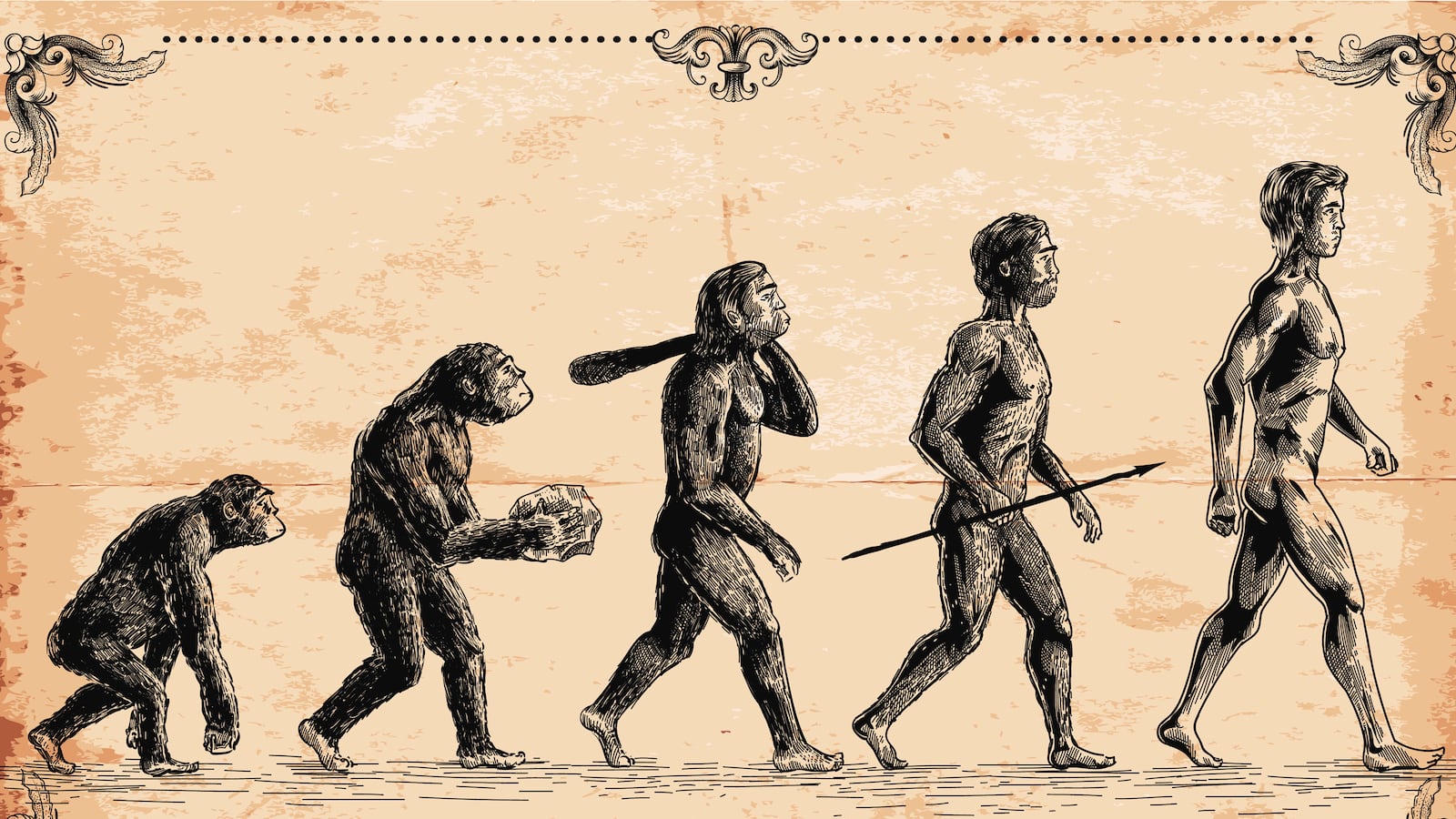On rare occasions, humans are born with tails—real functioning tails that can even be “wagged” via voluntary muscles contractions in response to emotional stimuli. Although the birth of a baby with a tail is frightening for parents and typically requires surgery, the remarkable human tail is an important part of the even more remarkable tale of our origins—namely evolution.

Human tails are part of the evolutionary baggage that we carry in our bodies, leftover from our ancestors. As we evolved through time, responding to different environmental pressures, natural selection pruned and edited, making our ancestors better at some things—like talking—while ignoring skills and characteristics that became less relevant in new contexts—like smelling. Unfortunately, natural selection has no mechanism to eliminate useless features, but traits that become irrelevant can atrophy or get co-opted for some other task since there is no longer a disadvantage when those features show up in a weakened form.
We carry the evidence of this long history in our bodies—features useful to our ancestors but, for various reasons, not to us. We have goose bumps, for example, that our hairy ancestors used to make their fur stand up straighter when they needed extra warmth or wanted to look menacing. We have muscles that some of us, including me, can use to wiggle our ears, which would be useful for locating sounds if our hearing was more acute. We have a bunched-up third eyelid in the corner of our eye that provided a transparent eye covering for our ancestors, allowing them to “blink” without have to fully shut down their vision.
We call this useless anatomical baggage “vestigial.” Every species has some of it. Flightless birds have non-functional wings. Blind fish living in dark caves have eyes that can’t see. Most pythons have atrophied useless pelvises floating inside their abdomens, not connected to anything.
Other historical markers can be found in our genes. We have a gene to make Vitamin C but, unfortunately for those sailors who died from scurvy, it is broken, so we have to get Vitamin C from our food. Chimpanzees and orangutans have the same broken gene, which can only have been inherited from our common ancestor for whom it was functional, as it still is for many animals.
Every human being embodies the history of our species in the form of stuff inherited from the past. We are walking museums of natural history but some of the exhibits are rather dreadful. And every other species—and there are millions of them—also carry vestiges of its life history.
These dreadful exhibits are the undeniable proof of evolution, linking present species with their ancestors in the clearest of ways. From Darwin to the present, the existence of bad, sinister, unintelligent design has provided powerful evidence that species were not created in their present forms but must have evolved over time—and evolved in such a way that the designs we encounter in ourselves and other species today are often the opposite of intelligent.
The presence of so much “unintelligent” design across so many species should demolish the central claims of the Intelligent Design movement. For every “irreducibly complex” thing with more design than can be accounted for by present science, there are a thousand things in nature with inferior levels of design. For every arrow pointing toward a “designer,” there are a thousand arrows pointing the other way.
How then, does the Intelligent Design movement (ID) persist, in the face of so much damning contrary evidence?
To understand this strange phenomenon, we have to appreciate that ID handles scientific evidence the way lawyers handle evidence in legal cases, namely paid to come to a foregone conclusion, no matter how poorly supported. If 1,000 people saw you commit the crime and Joe saw someone else do it, Joe’s testimony is the only one that matters to your defense lawyer. When someone from the 1,000 witnesses appears on the stand, your lawyer tries to make their integrity appear suspect, and to call their competence into question.
The weakness of any case becomes clear when the logic used to make the arguments is strained, selective and irrelevant. I have watched such tortured reasoning—much of it by a lawyer—in the aftermath of my debate with ID theorist Stephen Meyer a few weeks ago.
In the debate, I emphasized the problem of bad design that I outlined above, mentioning that bad design is common in nature and poses serious problems for ID. I gave some examples of bad design and showed a picture of an infant with a well-formed tail to illustrate one example.
The response was exactly what one would expect from lawyers. Rather than noting that apparent bad design was common and needed to be addressed by ID—a point I have made in several debates with creationists and ID theorists and has always been met with silence—the response focused exclusively on the particular example of the human tail, as if that is all that needs to be explained. One ID spokesperson, David Klinghoffer, claimed—falsely and absurdly—that I presented it a “proof of Darwinian evolution,” on which I was “very stuck.” (It is a piece of evidence, which is quite different than a proof.) Klinghoffer then attempted to undermine the argument from bad design by undermining the image I had used to illustrate my point. The image came from an article on Cracked.com which Klinghoffer described as the “vestigial online presence of an old satirical magazine, now defunct, a knockoff of Mad.” But where the image came from is of zero import; Klinghoffer’s point does absolutely nothing to undermine the universally accepted and fully documented reality that human babies are occasionally born with tails. Google has more than a million hits—and countless images—for the term “babies born with tails.”
Casey Luskin, also of the Discovery Institute, published several pieces on humans with tails that at least engaged the phenomena of tails, instead of the pedigree of the image I used. But rather than address the actual question on the table—how can ID account for bad design?—he focused exclusively on creating a tenuous speculation that there might be no such thing as genuine human tails.
Note the reasoning process here, keeping in mind that 1) there is a consensus in the scientific community that humans are sometimes born with real tails that are evolutionary throwbacks; 2) the gene for tails has been located in the human genome is the same one that mice use to produce their tails; and 3) the issue is not the human tail, but the problem of bad design in nature.
Luskin—a lawyer—starts by noting that there is “still much debate over why tails arise during development,” but fails to mention that this debate is not about whether the tail sometimes represents the reappearance of an ancestral feature. He notes that “at least one paper” recognizes that the cause of the tail is “poorly understood.” But his next logical leap is breathtaking.
The unwanted appendages attached to babies are classified as either “true tails,” which I have been discussing, or “pseudotails,” which are birth defects that only resemble tails, like a blob of flesh hanging from the lower back. The distinction between the two is common knowledge, and nobody is arguing that pseudotails provide evidence that we evolved from a tailed ancestor.
Luskin then quotes medical journals that, although certainly reputable, are not the typical sources for discussions of evolution. The articles are appropriately tentative—“we raise the suspicion”—in suggesting that pseudotails and “true tails” might actually be the same thing. If true, this would imply that the accepted evolutionary explanation for true tails should be abandoned, which would be significant, of course. Luskin, however, makes no reference to the vast literature arguing with considerable evidence for an evolutionary explanation for true tails.
Luskin makes the best argument he can, of course, but it is piecemeal and speculative. In the face of an overwhelming scientific consensus, he finds a few lone critics with a few tentative comments and amazingly ends up with “ample evidence,” to reject the received wisdom based on a much more substantial body of evidence. “Another evolutionary icon has fallen,” he concludes.
Klinghoffer and Luskin—and most everyone in the ID movement—employ the standard strategies of knowledge denial. Cigarette companies used identical tactics for decades to deny that smoking causes cancer. Today we see these tactics used to deny the scientific consensus on the causes of climate change, the safety of vaccinating children, or the age of the earth.
The strategy is always the same: toss irrelevant mud on the offending argument—“he got his picture from Cracked.com.” Find a lonely voice and enlarge its significance—“one expert thinks there are no true human tails.” Draw certain conclusions from uncertain evidence. Pluck a pebble from a mountain and pretend the mountain is gone. And never, ever, engage the actual argument on its own terms: why is there bad design in nature?
I am not trying to keep my debate with the ID “theorists” alive, for there is no debate about evolution. The generally accepted scientific ideas I presented remain alive and well and continue to guide thinking about evolution. What I do want to do, however, is shine a spotlight on the dangerous and slippery tools used by those who deny scientific knowledge.






